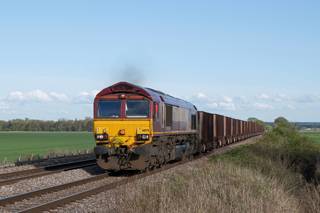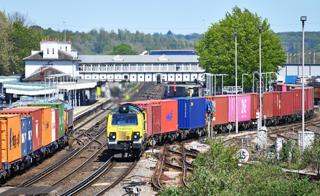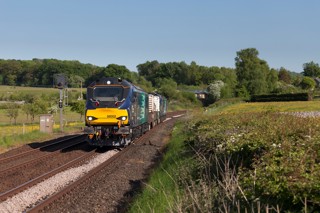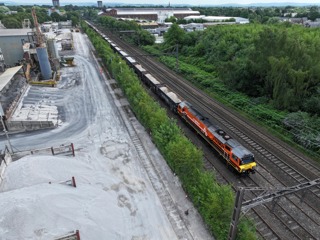- This feature was published in RAIL 880 (June 5-19 2019)
London’s troubled Crossrail project is not going to plan. Having spectacularly missed its much-publicised December 2018 opening date for the subterranean central section, it was confirmed on April 25 that a six-month period would now be targeted towards the end of next year to finally get trains up and running.
In the meantime, confusion continues to reign over who knew what - and when - concerning the delays, with a series of claims and counter-claims.
The National Audit Office (NAO), in its Completing Crossrail report published on May 3, was keen to clarify that there was no intention “to apportion blame for what has happened to the Crossrail programme. Our aim is to set out why and how the programme ran into difficulty, and what Crossrail Ltd needs to do to manage the remaining risks to the programme and deliver the promised benefits to passengers and the economy.”
A few days earlier Crossrail Ltd Chief Executive Mark Wild had said a similar thing to RAIL.
Wild is part of a new leadership team. It’s his job to guide the project to conclusion. But when that is, nobody knows - not even Wild, although Crossrail is working to a six-month window anywhere between October 2020 and March 2021 (RAIL 878).
The original plan was to open the project in five phases; but none have been on time - indeed, only one had been delivered by the day it was confirmed that the central core section would not open as planned last December.
Phase 1 was the introduction of Class 345 Aventra electric multiple units on the eastern section from Liverpool Street to Shenfield. This was supposed to have been in May 2017, but ended up being June owing to various problems with the trains. Such was the performance of the trains that then-Crossrail Chairman Sir Terry Morgan was moved to say he didn’t have a train that worked, when trying to justify the delays during one of the many subsequent inquiries into the project.
Phase 2 was the transfer of Heathrow Connect services to TfL Rail. This was supposed to involve ‘345s’ running between London Paddington (main line) and Heathrow Airport from May last year, but it didn’t happen and there is currently no date as to when this will start, although it’s hoped it will be early next year. This has been delayed owing to significant problems with the signalling (see panel).
Phase 3 was the start of central section running under the streets of London. Due in December 2018, this would entail trains running from Abbey Wood, through the city to Paddington (Crossrail station).
It was confirmed on August 30 that this would not happen, and various revised opening dates have since been suggested. This affected the rest of the project and has led to comments from Morgan, London Mayor Sadiq Khan and various organisations such as the London Assembly Transport Committee, seeking to attach blame while looking for answers (and in some cases distancing themselves from blame where possible).
Phase 4 was supposed to go live in May 2019, when trains from Shenfield would be diverted under the city to Paddington using the Pudding Mill Lane dive-under built south of Stratford. This was the location of a transformer explosion in November 2017 that some have suggested as the cause of the delays. Wild disagrees with that theory.
Finally, Phase 5 was the opening of the complete route between Shenfield/Abbey Wood and Heathrow/Reading from December 2019. This would create a 73-mile route with more than 40 stations, ten of which were new. Of those 73 miles, some 26 would be in new tunnels.
But that planning has gone awry - the intended dates have slipped. The NAO suggests the project team of the past was too wedded to the December 2018 target for the central section, and that this had a negative impact on the entire scheme.
Sat in the new Transport for London offices in Stratford, Wild is busy drawing a diagram for RAIL to show the project and a timeline.
“The stations should have been complete in 2016, with trains running on test in 2017,” he says.
In the event, the first train entered a tunnel in February 2018, with limited trial running beginning last summer.
“It does take a long time to get normal CBTC systems to function,” Wild explains when asked about the signalling delays. But he suggests that using these systems is not a new concept, highlighting the Paris RER network as operating in a similar fashion.
“We will be using ETCS Baseline 3. Currently I think it is Baseline 2 on Thameslink. For us, the biggest constraint is that it needs to be right.
“A misconception of Crossrail is that it’s complicated. The system is a good idea and it makes it interoperable with the national network. It’s smart to have ETCS in the suburban section and CBTC in the central section.”
The complex nature of the project is not lost on Wild. He explains that the stations support the tunnel, and that the new management team wants the stations complete so that the trains can begin trial running next year.
Back in August last year, TfL told RAIL that autumn 2019 was the intended date for the central section to open to passengers, and that “a final view was formed in August following a comprehensive review of the remaining programme”.
Back then, it was said that no one single element caused the delay.
“The original programme for testing has been compressed by more time being needed by contractors to complete fit-out activity in the central tunnels and the development of railway systems software,” TfL told RAIL at the time.
“If you fast forward from 2015 to the middle part of last year, none of the stations were complete. Siemens and Bombardier were delayed and the tunnels were not fitted with the signalling. There was a myriad of reasons, but nothing was finished.”
Wild says slippages began in 2015-16 - a statement supported by the NAO report.
He adds: “I arrived in December. Now we’ve had a chance to re-plan. This is an amazing project. It’s world-leading - the tunnelling is sensational. We have stood back and got a reasoned view.”
From this ‘standing back’, Wild says the new management team believes Crossrail must be completed in a sequence. “There were too many activities going on,” he says.
The NAO report confirmed that 36 major contracts were ongoing, and that this was having a detrimental impact on the delivery plan.
Wild continues: “The first thing is a complete change in the senior team. The previous team were fantastic, but they were not railway people.”
He says that if you go back a year, there were suggestions that one possible solution proposed was a partial opening between Abbey Wood and Canary Wharf. But he maintains: “It’s not a bad idea, but we want to open end-to-end because that creates the trust with passengers.”
Initially, the plan through the central section was for 15 trains per hour, but that was reduced to 12tph. When Stage 4 is finally up and running, then it will rise to 24tph.
Wild says Stage 5A will entail running trains to Reading, and that this will start in December this year with 6tph in the peak and 4tph off-peak. Oyster ticketing will be available for passengers. The full-length nine-car ‘345s’ will be deployed on these services, which will initially use the main line station at Paddington.
“This is where my railwayman instinct comes in, as this solution offers two things: a nice new train for passengers, and a chance to build reliability of the trains,” says Wild.
He bats away suggestions that the ‘345’ was a key cause of the delays, pointing out that “the train isn’t the most late thing”, although he does acknowledge that having up to half of the 70-strong order standing at Old Oak Common for several months awaiting their delayed entry into service isn’t good. “It’s a disappointing situation as mechanically they are good.”
The project has now been resequenced, Wild explains. Fitting out of the tunnels needs to be completed, as (for example) the pumps and lighting has not been finished. This will be done over the next six months.
“Then, every station needs to accept the train. There are up to eight storeys, and the last three support the train as that is where the systems and platform are.”
Bond Street will open later than the other central section stations: “It’s the furthest behind. Previously on Crossrail there were fixed dates, and the team were compressing the running and trials.”
Wild says the decision not to open Bond Street straightaway is about what’s best for the overall scheme. If trial running goes well, there could be the situation whereby the introduction of passenger services could be held up because Bond Street is not ready.
He explains: “Bond Street is decoupled from the rest of the scheme. It’s about one year behind the rest. Tottenham Court Road will be complete in August or September this year. Bond Street is delayed as it got off to a late start. The tunnelling was late and the shaft had to be redesigned. But it will open pretty quickly after the others.”
Meanwhile, under the revised plan, he says that trains will still be able to pass through the station carrying passengers.
The trial running is vital, and must be completed in three sections, says Wild. “We could start this in early 2020, it’s the dynamic testing down there at the moment. We test in each tunnel with four trains. That is about getting a safety certificate. There are maybe hundreds of tests to do. These are controlled, and that is the reason we only have the four trains involved.
“We then need to really stress test with 24tph. That process is why there’s a window of opening, as we don’t know when that will start. We expect December 2020 for passenger services, but it could be either side as it depends entirely when the trial running begins.”
He’s also keen to point out just how rigorous the testing programme is: “We really are keen on people’s safety. There are cameras on every station that must be tested - hundreds of them - and we have to get the right angle for crime deterrent and so on. Then there are the fire systems, public address…”
At this point, Wild explains what he believes happened previously: “I think there was a lack of understanding, and the aggregation of risk was there. The risk should have been known earlier. Every system - CBTC, ETCS, the tunnel ventilations - they are all built, but it has to be to the highest safety and standards.”
Following the announcement on April 25 regarding the further delays to the December 2018 opening plan, Wild counters: “One of the really great things is we have a really robust idea. Previously it was missing the conveyance of the systems, but now we have a plan. It’s about getting to 5A at Christmas, and as soon as we can after Christmas we can get to Heathrow. The constraint then is driver training.”
But is Wild confident that the latest announced date is achievable? After all, there have been plenty of suggested dates before.
“We’d not have gone public if we were not confident. The breakthrough will be the trial running. Once that is complete, we then do two to three months’ shadow running and we’ll probably use TfL travel ambassadors for that. With that you simulate everything - passengers being ill, bags being caught in doors, coffee being spilled, etc.”
Another part of the project is the work being carried out by Network Rail on the western section. Some work remains to be completed, including platform extensions and commissioning work. Infrastructure to support the Driver Only Operation of the Crossrail trains also needs to be complete, but Wild says this is not a concern, and that NR Chief Executive Andrew Haines is supportive of the project.
And he is optimistic. He knows that Crossrail is a challenge, but says with a smile: “It will be worth the wait.” London certainly hopes so.
Crossrail signalling
Crossrail will use three separate signalling systems: Train Protection Warning System (TPWS), Communications-Based Train Control (CBTC), and European Train Control System (ETCS).
CBTC will be used in the central section, while at the western end the trains will use ETCS and TPWS. ETCS is being installed on the whole route between Paddington and Heathrow. TPWS will be used westbound to Reading.
In the east, Crossrail will use TPWS.
Responsibility for the implementation lies with the infrastructure owners, so it’s Network Rail between Paddington and Airport Junction, and Heathrow Airport Limited from there to the terminal stations.
However, ETCS was supposed to be in place from Paddington, but has only been implemented in the Heathrow Tunnel. This has added to the complexity of signalling integration, as there is an additional interface to account for between ETCS in the Airport Junction and NR’s legacy signalling system (TPWS) in the eastern line from Paddington.
The information from these three separate signalling systems will be integrated by the on-board software Train Control and Management System (TCMS). The ability of this software to switch between these three systems, as trains move along the various parts of the route, will guarantee safe and efficient operation.
The National Audit Office’s May 3 report Completing Crossrail shows that Bombardier’s development of software and on-board signalling systems required to operate the trains had been “significantly delayed”.
Such was the situation that in July 2017, Crossrail Ltd raised an Adverse Event Notice to the sponsors, stating that the opening of services on the western section and the central section were at risk as it had taken Bombardier and Siemens some 18 months longer than planned to develop and test the train and signalling software needed to operate the three separate systems.
There have been further delays, caused by delays to the installation of signalling equipment in the tunnels and stations in the central section.
















Login to comment
Comments
No comments have been made yet.